The diversity of animal diets is essential for their health and well-being. Animals that consume a variety of foods experience improved growth and reduced stress. Herbivores thrive on multiple plant species, while omnivores enjoy flexible diets that enhance nutrient intake. Such dietary variety boosts performance, lowers cortisol levels, and supports ecological balance. Understanding these dietary preferences can lead to better animal welfare practices. Explore the fascinating connections between diet, health, and animal behavior.
Key Takeaways
- Dietary diversity is essential for animal health, enhancing growth rates and reducing physiological stress through varied nutrient intake.
- Herbivores benefit from consuming a range of plant species, improving their health and ecosystem resilience.
- Carnivores primarily consume protein-rich diets, while omnivores have flexible feeding strategies that include both plants and animals.
- Functional dietary diversity allows animals to express choice, improving their well-being and immune responses.
- Future research should focus on enhancing dietary diversity to elevate welfare in livestock and herbivore populations.
Understanding Dietary Diversity in Animals
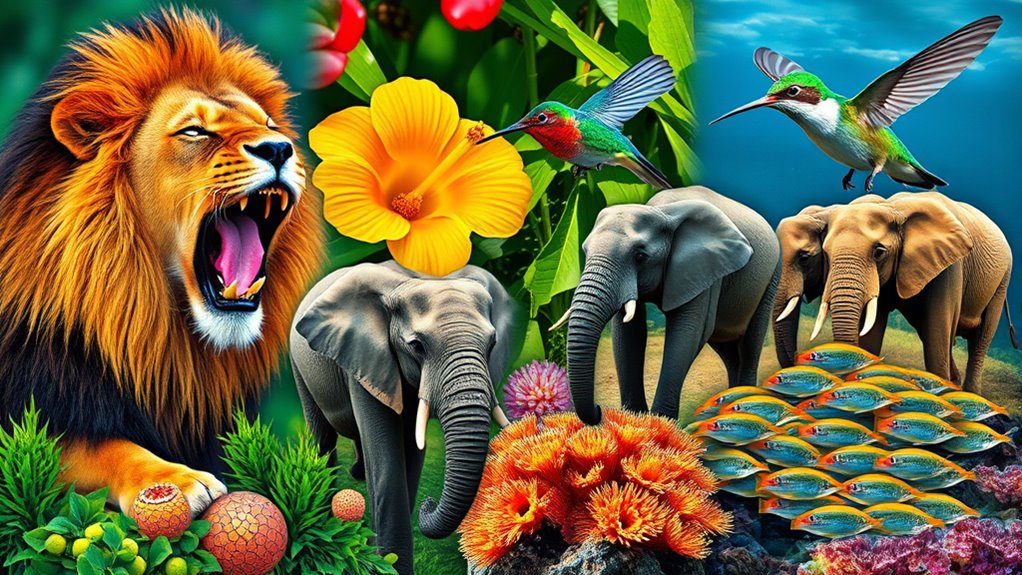
When you consider the diets of animals, especially ruminants, it's clear that dietary diversity plays an essential role in their health and well-being.
By incorporating a range of primary and secondary plant compounds, ruminants can better meet their nutritional needs. This functional dietary diversity allows them to make individual dietary choices, considerably lowering physiological stress levels.
Incorporating diverse plant compounds empowers ruminants to meet their nutritional needs and reduce stress levels.
Studies show that ruminants with diverse diets experience improved animal performance, including a 130% increase in average daily gain and a 26% boost in hot carcass weight.
Moreover, the taxonomic diversity in their diets enhances the hedonic value of feed, encouraging higher intake rates.
Ultimately, dietary diversity not only promotes growth but also supports overall welfare and satisfaction in ruminants.
The Impact of Diet on Animal Health and Performance
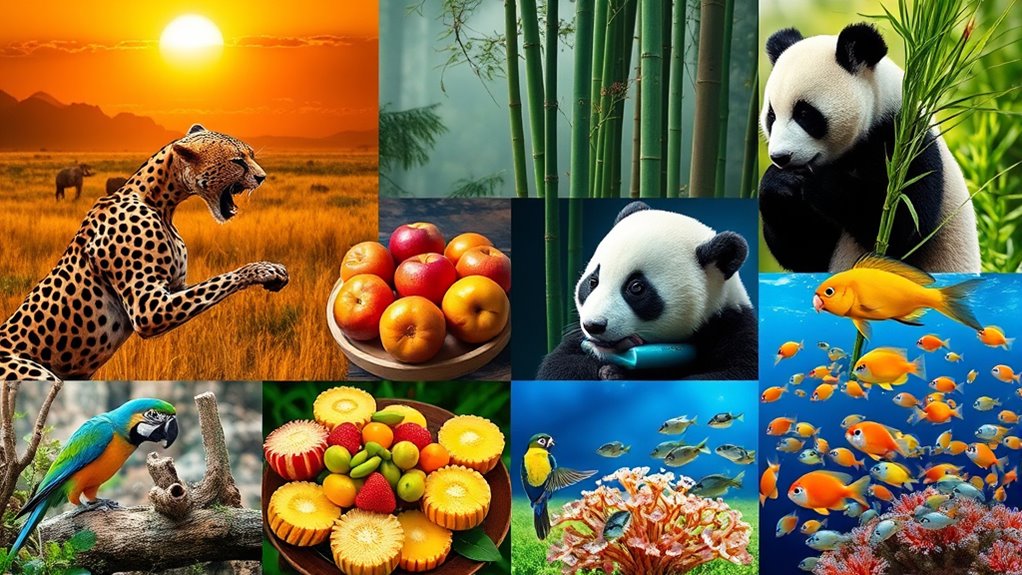
Diet importantly influences animal health and performance, shaping everything from growth rates to overall well-being. A diverse diet can boost average daily gain by 130% and increase hot carcass weight by 26%, enhancing animal performance considerably.
Including plant secondary compounds helps reduce oxidative stress, promoting better health. Functional dietary diversity allows animals to choose their nutrition, lowering physiological stress and improving feed conversion efficiency. This choice not only enhances their hedonic value but also leads to higher intake and better nutritional outcomes.
Additionally, animals with diverse diets show lower cortisol levels, reflecting reduced stress and improved well-being, which ultimately contributes to greater productivity and health in livestock. Embracing dietary diversity is key for ideal animal performance.
Herbivores: Adapting to Nutritional Needs
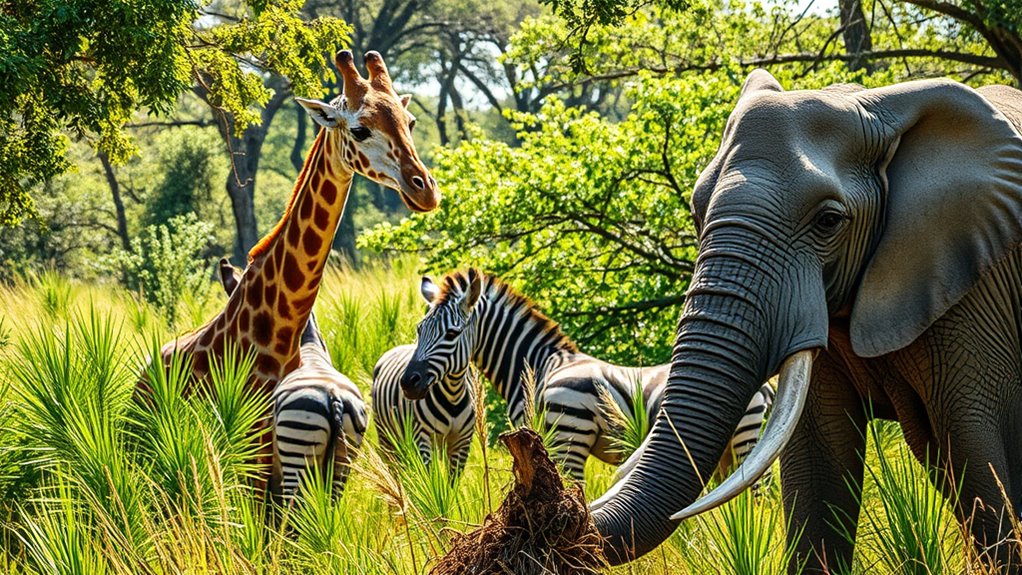
Herbivores thrive on a diverse range of plant species, which plays an essential role in their nutritional balance. By consuming various plants, you help meet your nutritional requirements while enhancing your overall well-being.
- Greater dietary diversity improves growth performance.
- Access to primary and secondary compounds boosts health.
- Natural dietary choices reduce physiological stress.
- Self-medication through plant secondary compounds can reduce disease risks.
When you explore a variety of forage, you not only enjoy your meals more but also benefit from the rich mix of nutrients.
This dietary diversity leads to improved average daily gains, as seen in studies with lambs on mixed diets. Embracing different plant species can truly make a difference in your health and growth.
Carnivores and Omnivores: Diverse Feeding Strategies

While carnivores and omnivores may seem quite different in their eating habits, both groups demonstrate remarkable adaptability in their feeding strategies. Carnivores, equipped with sharp teeth and claws, primarily consume protein-rich diets, allowing them to thrive in various ecosystems. In contrast, omnivores, like humans and bears, enjoy diverse diets that include plants and animals, enhancing their survival chances. Their flexible feeding strategies let them exploit a variety of food sources, reducing competition for resources. Interestingly, some omnivores can also safely consume certain fruits, such as apples and pears, which can provide additional nutritional benefits.
| Category | Carnivores | Omnivores |
|---|---|---|
| Diet Type | Animal flesh | Plants and animals |
| Digestive System | Shorter gastrointestinal tract | Longer gastrointestinal tract |
| Adaptability | Seasonal hunting strategies | Versatile food exploitation |
| Environmental Impact | Specialized diets impact ecosystems | Broader resource utilization |
Ecological Importance of Dietary Variety

Understanding the ecological importance of dietary variety is key to grasping how herbivores thrive in changing environments.
When you look at biodiversity, you see that a wider range of plant consumption boosts ecosystem resilience and offers nutritional benefits for these animals.
This flexibility not only helps herbivores adapt to resource fluctuations but also supports their role in maintaining stable ecological networks.
Biodiversity and Ecosystem Resilience
Dietary diversity plays an essential role in enhancing ecosystem resilience, particularly among large herbivores. When herbivores consume a wide variety of plants, they support diverse plant communities, which helps cushion ecosystems against disturbances.
Here's why this matters:
- Stability in populations: High taxonomic dietary diversity leads to more stable herbivore populations.
- Resource robustness: Generalist herbivores thrive better during resource fluctuations, boosting ecosystem resilience.
- Food web dynamics: Greater phylogenetic dietary diversity influences how species interact within ecological networks.
- Species distribution: Understanding dietary diversity helps us grasp species distribution and ecosystem health amid environmental changes.
Nutritional Benefits for Herbivores
Herbivores thrive when they've access to a diverse array of plant species, as this variety is vital for meeting their nutritional needs.
Dietary diversity allows you to select from different plant species, fulfilling your macro- and micronutrient requirements. When you consume a varied diet, you're less likely to experience oxidative stress, thanks to natural antioxidants found in diverse plants.
Studies show that herbivores with higher taxonomic dietary diversity exhibit improved growth performance, enhancing overall welfare. Plus, plant secondary compounds can boost your immune responses and reduce disease prevalence.
Ultimately, having dietary choices decreases physiological stress, leading to better emotional and behavioral outcomes. Embracing a diverse diet is essential for your health and well-being.
Adaptations to Environmental Changes
When facing environmental changes, adapting your diet can be a game-changer for resilience. Dietary diversity among herbivores is essential for thriving in fluctuating ecosystems. Consider the following aspects:
- Greater resilience: Generalist herbivores withstand disturbances better than specialists.
- Seasonal adaptability: Mixed-feeders adjust their diets based on plant availability and nutritional quality.
- Ecological importance: Diverse feeding behaviors influence plant community dynamics.
- Biodiversity impact: Low dietary diversity can lead to vulnerabilities in herbivore populations.
Understanding these adaptations highlights how herbivores manage environmental changes.
Managing Animal Diets for Biodiversity Conservation
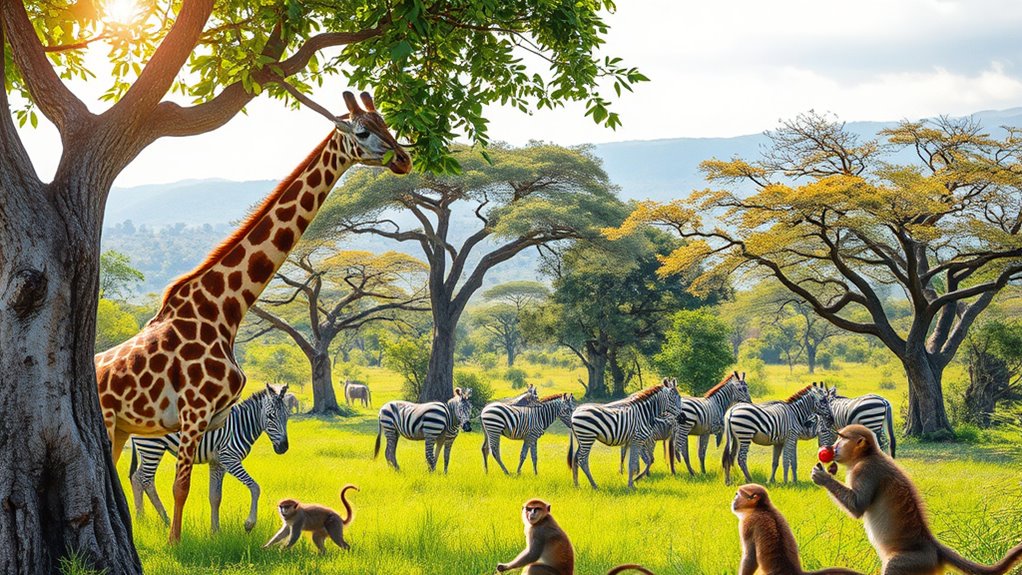
When you manage animal diets with a focus on diversity, you not only enhance their nutritional choices but also promote ecosystem resilience.
By supporting a variety of plant species, you create a healthier habitat that benefits both livestock and wildlife.
This approach ultimately improves animal welfare while contributing to the conservation of biodiversity.
Enhancing Nutritional Choices
Enhancing nutritional choices for ruminants not only boosts their health but also supports biodiversity conservation.
By embracing Functional Dietary Diversity, you enable these animals to make individual dietary choices, leading to reduced oxidative stress and improved overall well-being.
Here are some key benefits of diverse diets:
- Improved animal performance through better feed conversion efficiency
- Higher average daily gains and carcass weights from varied nutritional options
- Enhanced antioxidant status thanks to the intake of plant secondary compounds
- Increased ecological resilience as diverse diets make ruminants less sensitive to environmental changes
Promoting Ecosystem Resilience
Promoting ecosystem resilience through effective management of animal diets is essential for biodiversity conservation. By fostering dietary diversity, you enhance the well-being of herbivores, allowing them to make dietary choices that support their health and purpose.
High taxonomic dietary diversity helps large herbivores adapt to environmental disturbances, giving them the resilience to cope with resource fluctuations. Studies show that animals with varied diets are less impacted by plant extinctions, maintaining ecological balance within their habitats.
Additionally, implementing diverse feeding strategies boosts nutrient use efficiency in livestock, reducing waste and minimizing environmental impact. Through strategic management of grazing patterns, you can conserve plant biodiversity, prevent overgrazing, and encourage the regeneration of diverse plant species critical to a thriving ecosystem.
Supporting Animal Welfare
Supporting animal welfare through the management of diets that prioritize biodiversity is essential for both animal health and ecological balance.
By promoting functional dietary diversity, you enable animals to express individual choice, enhancing their eudaimonic well-being. This approach reduces physiological stress and improves growth performance.
Here are some key points to contemplate:
- Diverse diets can boost average daily gain by 130% compared to monotonous options.
- Taxonomically varied plants enhance biochemical diversity and provide crucial nutrients.
- Self-selection from a varied diet improves nutrient intake and immune responses.
- Phytochemical-rich diets are linked to better overall health and well-being.
Managing diets for biodiversity not only benefits animal welfare but also supports a healthier ecosystem.
Future Directions in Dietary Research and Animal Welfare
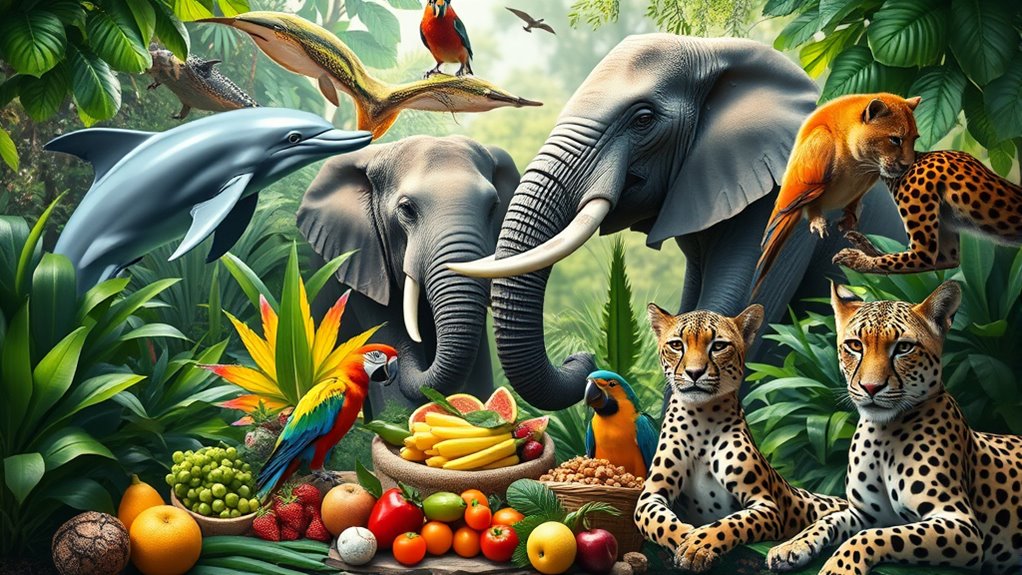
As researchers explore the future of dietary practices in livestock, the focus increasingly shifts to enhancing functional dietary diversity (FDD) to elevate animal welfare. By allowing animals to choose from diverse plant options, you can improve hedonic and eudaimonic well-being, reducing physiological stress.
Studies show that dietary diversity can boost growth performance, with lambs experiencing a 130% increase in average daily gain. Additionally, incorporating diverse forages enhances antioxidant defense, reducing oxidative damage and promoting overall health.
Understanding the relationship between taxonomic and phylogenetic dietary diversity will guide you in improving resilience in herbivore populations. Prioritizing diverse diets not only benefits animal welfare but also aligns with livestock production goals, ensuring healthier animals and higher-quality products.
Frequently Asked Questions
What Animal Has the Most Diverse Diet?
If you're curious about which animal has the most diverse diet, you might want to contemplate the brown bear.
It eats a range of foods, from fruits and nuts to fish and small mammals, depending on the season. This adaptability allows it to thrive in various environments.
African elephants and red foxes also showcase impressive dietary variety, but the brown bear often stands out due to its wide-ranging menu throughout the year.
What Are the 4 Types of Animal Diets?
When you think about animal diets, there are four main types to contemplate.
You've got herbivorous animals that eat plants, like cows and sheep.
Then there are carnivorous creatures that feast on meat, such as lions and eagles.
Omnivorous animals, including humans and bears, enjoy a mix of both plants and animals.
Finally, detritivorous species, like earthworms, break down dead organic matter, playing an essential role in nutrient recycling within ecosystems.
What Is the Diversity of Animals?
When you think about the diversity of animals, consider how they adapt to various environments and conditions.
You'll find species with unique physical traits, behaviors, and life cycles, all tailored to their habitats. This diversity contributes to ecosystems' resilience and balance.
By recognizing these differences, you appreciate the complex interactions among species, which can range from predation to symbiosis.
Understanding this variety helps you grasp the intricate web of life on Earth.
What Is Diet for Diversity?
So, you think a boring diet is just fine, huh?
Well, diet for diversity means you're actually missing out on a world of flavors and nutrients. When you mix things up, you boost your health and happiness. A varied diet helps you get essential vitamins while keeping your taste buds excited.
Plus, it can improve how your body functions. So, why settle for the same old meals when you could enjoy a colorful plate?
Conclusion
In exploring the diversity of animal diets, you've seen how essential it is for health, performance, and ecological balance. Whether it's herbivores, carnivores, or omnivores, each group adapts uniquely to their dietary needs. By managing these diets effectively, we can support biodiversity and animal welfare. Isn't it fascinating how what animals eat can shape entire ecosystems? As research advances, let's continue to prioritize and celebrate this rich tapestry of life.










